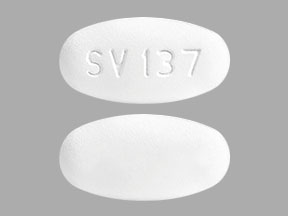Dolutegravir / Lamivudine Dosage
Medically reviewed by Drugs.com. Last updated on Apr 4, 2025.
Applies to the following strengths: 50 mg-300 mg
Usual Adult Dose for:
Additional dosage information:
Usual Adult Dose for HIV Infection
1 tablet orally once a day
Uses: As a complete regimen, for the treatment of HIV-1 infection in patients with no antiretroviral treatment history or to replace a stable antiretroviral regimen in patients who are virologically-suppressed (HIV-1 RNA less than 50 copies/mL) with no history of treatment failure and no known substitutions associated with resistance to the individual components
Renal Dose Adjustments
CrCl less than 30 mL/min: Not recommended.
Comments:
- Patients with sustained CrCl between 30 and 49 mL/min should be monitored for hematologic toxicities.
- If lamivudine dose adjustment is indicated (e.g., patient develops new/worsening neutropenia or anemia), this drug should be discontinued and the individual components should be used.
Liver Dose Adjustments
Mild or moderate liver dysfunction (Child-Pugh A or B): No adjustment recommended.
Severe liver dysfunction (Child-Pugh C): Not recommended.
Dose Adjustments
Coadministration with carbamazepine or rifampin: An additional 50 mg/day of dolutegravir is recommended, separated from this combination product by 12 hours.
Precautions
US BOXED WARNINGS:
PATIENTS COINFECTED WITH HBV AND HIV-1:
- EMERGENCE OF LAMIVUDINE-RESISTANT HBV: All patients with HIV-1 should be tested for HBV before/when starting this drug. Emergence of lamivudine-resistant HBV variants associated with lamivudine-containing antiretroviral regimens reported. If this drug is used in HBV/HIV-1-coinfected patients, additional treatment should be considered to appropriately treat chronic HBV; otherwise, an alternative regimen should be considered.
- EXACERBATIONS OF HBV: Severe acute exacerbations of HBV reported in HBV/HIV-1-coinfected patients who have stopped lamivudine, a component of this drug. Hepatic function of HBV/HIV-1-coinfected patients should be monitored closely; if appropriate, anti-HBV therapy should be started.
CONTRAINDICATIONS:
Prior hypersensitivity reaction to either active component; coadministration with dofetilide
Safety and efficacy have not been established in patients younger than 18 years.
Consult WARNINGS section for additional precautions.
Dialysis
Data not available
Other Comments
Administration advice:
- Before/when starting this drug, test patients for HBV infection.
- Pregnancy testing is recommended before starting this drug in patients of childbearing potential.
- Administer with or without food.
- Administer products containing polyvalent cations (e.g., aluminum or magnesium) and oral supplements containing calcium or iron (including multivitamins containing calcium or iron) 6 hours before or 2 hours after this drug; may administer supplements/multivitamins containing calcium or iron and this drug at the same time with food
- Consult the manufacturer product information regarding missed doses.
Storage requirements:
- Store below 30C (86F).
General:
- Each combination tablet contains dolutegravir 50 mg and lamivudine 300 mg.
Monitoring:
- General: Pregnancy testing in patients of childbearing potential (before starting therapy)
- Hematologic: For hematologic toxicities in patients with sustained CrCl between 30 and 49 mL/min (during therapy)
- Hepatic: For hepatotoxicity (during therapy); hepatic function of HBV/HIV-1-coinfected patients with clinical and laboratory follow-up (for at least several months after stopping this drug)
Patient advice:
- Read the US FDA-approved patient labeling (Patient Information).
- Contact health care provider at once if rash develops; stop this drug immediately and seek medical attention if rash associated with any of the following symptoms develop: fever, general ill feeling, extreme tiredness, muscle/joint aches, blisters/peeling of skin, oral blisters/lesions, eye inflammation, facial swelling, swelling of eyes/lips/tongue/mouth, difficulty breathing, and/or signs/symptoms of liver problems (e.g., yellowing of skin/whites of eyes, dark/tea-colored urine, pale-colored stools/bowel movements, nausea, vomiting, loss of appetite, pain/aching/sensitivity on right side below ribs).
- Monitor for hepatotoxicity during therapy.
- Patients of childbearing potential (including those actively trying to become pregnant): Discuss the risks and benefits of this drug with health care provider to decide if alternative therapy should be considered at time of conception through the first trimester of pregnancy; contact health care provider if pregnancy is confirmed in the first trimester.
- Patients of childbearing potential: The consistent use of effective contraception is recommended.
- Notify health care provider at once of any signs/symptoms of infection.
Frequently asked questions
More about dolutegravir / lamivudine
- Check interactions
- Compare alternatives
- Reviews (50)
- Side effects
- During pregnancy
- Drug class: antiviral combinations
- En español
Patient resources
Other brands
Professional resources
Other brands
Related treatment guides
See also:
Further information
Always consult your healthcare provider to ensure the information displayed on this page applies to your personal circumstances.


